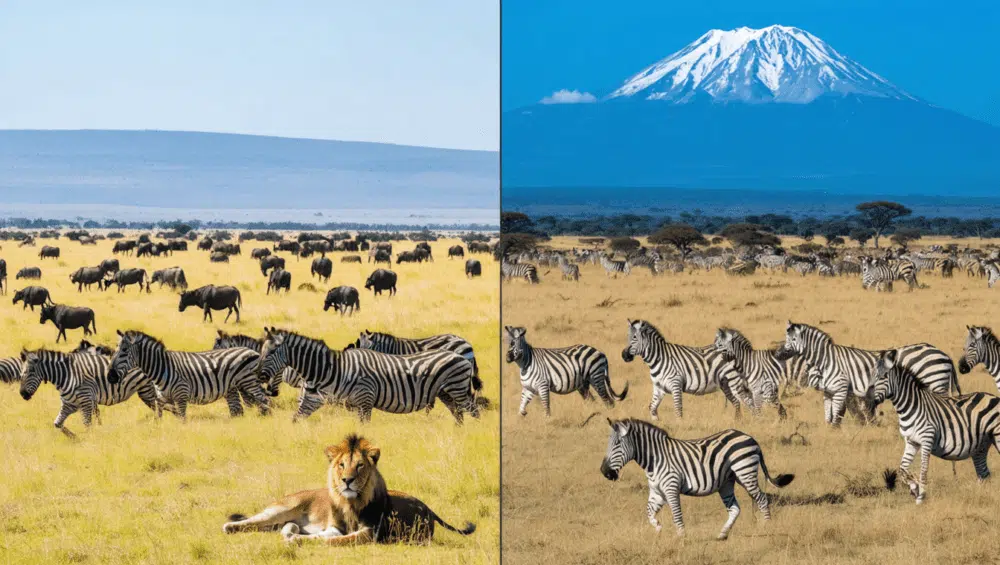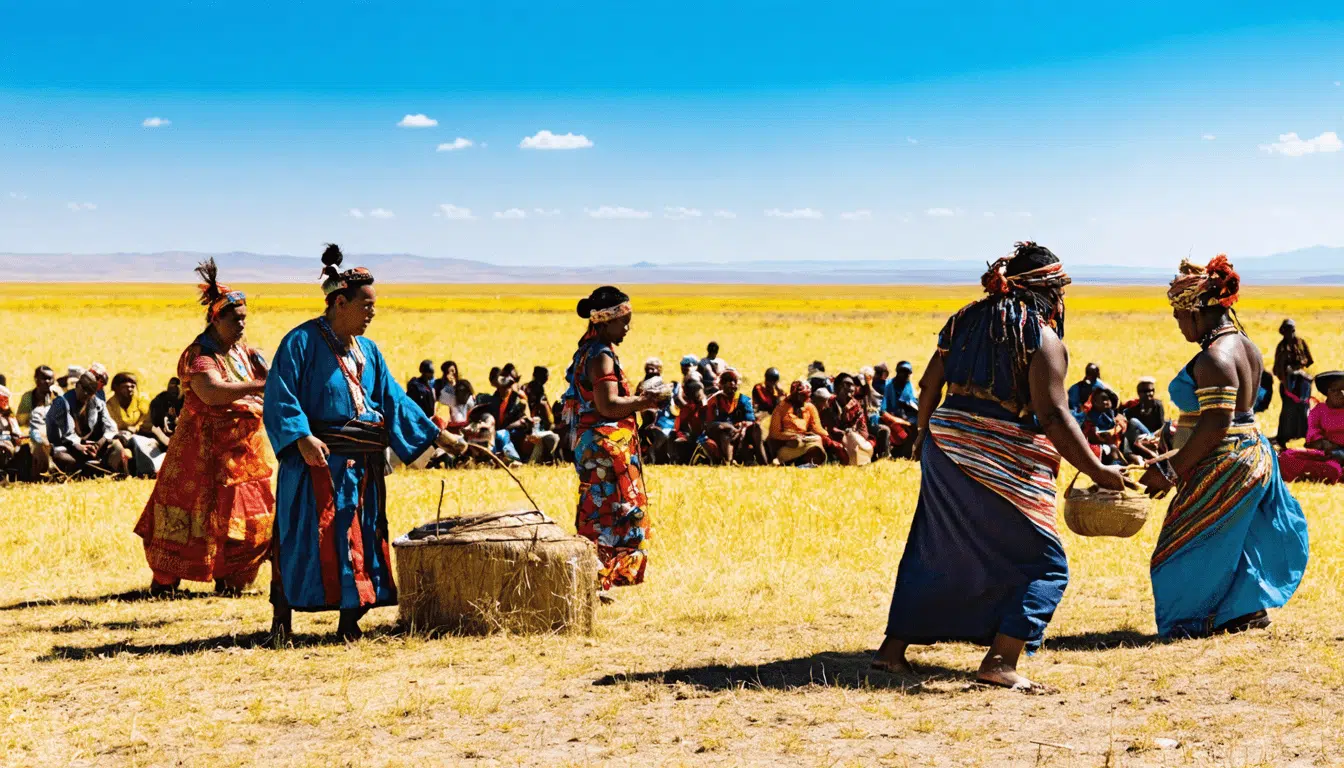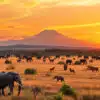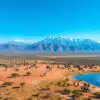Introduction to Safari Destinations: Kenya vs. Tanzania
Ah, the age-old debate: Kenya or Tanzania for a safari? Both names roll off the tongue like a dream, promising adventure, unforgettable landscapes, and wildlife encounters so exhilarating they could be straight from a nature documentary. Choosing between these two East African giants can seem as daunting as deciding which sweet to pick from a box of chocolates—do you go for the one with the gooey caramel center or the one filled with nutty surprises?
Africa is dotted with premier safari destinations, each offering its own signature cocktail of beauty and thrill. Yet, when people think of the ultimate safari experience, Kenya and Tanzania often top the list. Not without reason. The decision really hinges on what calls to you personally—the thundering herds of the Great Migration, the quintessential acacia-dotted plains, or the soul-stirring sunsets that splash across expansive savannahs.
Sure, it sounds romantic and a little poetic. But at the heart of this choice lies some seriously practical considerations. Are you drawn to the call of Kenya’s Maasai Mara or does Tanzania’s Serengeti soar higher on your bucket list? Are you angling for exclusive game viewing or are you more culturally inclined, eager to learn from local communities like the Maasai? Here’s the scoop: while both nations offer unique safari treasures, understanding the distinct experiences each one brings is crucial for crafting that perfect, tailor-made adventure.
Now, let’s embark on this journey and sift through what each of these stunning countries has to offer. From wildlife diversity to cultural riches and practical travel tips, this comparison aims to assist you in plotting a safari that matches your wildest dreams. Ready to dive in? Let’s go!
Introduction to Safari Destinations: Kenya vs. Tanzania
When it comes to safaris, Africa is the canvas on which Mother Nature paints her wildest strokes. Among the continent’s crown jewels are Kenya and Tanzania, two countries that have mesmerized intrepid travelers, amateur photographers, and wildlife enthusiasts alike. The thought of exploring the African savannah, spotting a lion stretching lazily in the sun or a herd of elephants marching with steadfast purpose, ignites a wanderlust that many find hard to resist. But where should you start? Kenya or Tanzania? Let’s unravel this conundrum.
Embarking on a safari is no small feat, and choosing the right destination can significantly enhance your encounter with Africa’s dramatic landscapes and diverse wildlife. It’s like trying to pick between two flavors of your favorite ice cream—both equally tempting but each with its unique twist. Do you prefer the bustling vibrancy of Kenya’s Maasai Mara, rich with the tales of the Maasai warriors, or the lush, sprawling plains of Tanzania’s Serengeti, where the Great Migration awes spectators annually? Such decisions often come down to personal taste and interests, yet understanding the nuances of each country can help set the stage for an unforgettable adventure.
Why Kenya?
Often dubbed as the homeland of safari, Kenya brings to life the quintessential African safari experience. Picture this: driving through the Maasai Mara, your Jeep bouncing slightly on rugged paths as you sit, binoculars poised. You catch a glimpse of the Big Five—lions, elephants, buffaloes, leopards, and rhinoceros—all in one day. It’s possible here. The savannah seems to pulse with life, from the tiny movements of a dung beetle to the powerful strides of a cheetah. And then there’s Amboseli, home to the mighty elephants who roam against the backdrop of the majestic Mount Kilimanjaro, showing off its snow-capped peak from just across the border in Tanzania.
Kenya’s magic doesn’t end with its wildlife; it extends into the rich cultural tapestry woven by the communities that call this land home. Engage with the Maasai, a semi-nomadic people who, despite the encroaching modern world, continue to preserve their rich heritage and vibrant traditions. Imagine joining a Maasai group as they perform their traditional jumping dance, known as ‘Adumu’, and participating in their vibrant festivals. The authenticity of such cultural exchanges can transform a trip from memorable to life-altering.
The Allure of Tanzania
Switching gears, let’s gaze into the sprawling expanses of Tanzania. The Serengeti National Park is the battleground where a natural spectacle unfolds every year: the Great Migration. Over a million wildebeest and countless zebras traverse the plains in search of greener pastures, playing a high-stakes game of life and death with predators like Nile crocodiles and lions lying in wait. It’s nature’s grand drama, reminding even the most well-seasoned traveler of the raw beauty and cruelty of the natural world.
Beyond the Serengeti, Tanzania offers the Ngorongoro Crater, a vast volcanic caldera rich in biodiversity. Imagine standing on the crater’s edge, gazing down at the ‘Garden of Eden’ filled with everything from hippos wallowing in the water to flamingos painting its lakes pink. Tanzania’s parks invite you to immerse yourself fully, losing track of time as you absorb the landscape around you.
Of course, no safari story is complete without a nod to the people. Tanzania’s cultural experiences often revolve around the Hadzabe tribe, who are among the last true hunter-gatherers left in Africa. Engaging with these communities is more than just tourism; it’s a rare opportunity to glimpse a lifestyle that has persisted for thousands of years. You might find yourself questioning your own way of life after a day spent learning their skills and stories, realizing there’s much more to life than gadgets and schedules.
So, Kenya or Tanzania? The beauty of this choice is that there isn’t a wrong answer. Both countries offer profound and stirring experiences, interconnected in their shared love of wildlife and nature yet distinct in their cultural expressions. Ultimately, whether you find yourself swept up by the spirit of the Maasai or entranced by the rhythm of the Wildebeest Migration, Africa will inch its way into your heart, calling you back for more. What’s your next adventure going to be?
Wildlife Diversity and National Parks Comparison
When it comes to safari experiences, two names instantly come to mind: Kenya and Tanzania. These neighboring countries are like siblings who share more than just a border—they share a legacy of wildlife wonders and breathtaking landscapes. But how do they stack up against each other when it comes to wildlife diversity and national parks? Let’s dive into the heart of Africa and compare.
The Majesty of Kenya’s Maasai Mara and Amboseli
Have you ever seen those documentaries on the Great Migration and wondered what it would be like to witness it firsthand? Well, the Maasai Mara in Kenya is where you can turn that dream into reality. Known for the legendary wildebeest migration, the Mara is teeming with not just wildebeest, but zebras, gazelles, and an impressive line-up of predators like lions and cheetahs. Visiting around July to October can guarantee you a front-row seat to this natural spectacle.
And then there’s Amboseli National Park, where the iconic sight of elephants ambling across the plains against the backdrop of Mount Kilimanjaro awaits you. It’s not just elephants; Amboseli offers sightings of buffaloes, giraffes, and a rich birdlife, making it an avian paradise. Ever caught yourself dreaming of lounging under the shadow of Africa’s highest peak while spotting wildlife? Amboseli might just be the slice of heaven you’ve been seeking.
Tanzania’s Serengeti and Ngorongoro: Nature’s Masterpiece
If the world could crown a winner for the most famous wildlife preserve, Tanzania’s Serengeti would certainly be in the running. Rivaling the Maasai Mara, the Serengeti is the stage for part of that same Great Migration, especially in June and July. And it’s not all about the movement; it’s about the rhythm of life—the births, the hunts, the everyday dance of existence. Who wouldn’t want to be part of that audience?
The Ngorongoro Crater, another Tanzanian gem, is like a natural amphitheater bustling with life. Imagine being surrounded by the Big Five—lions, elephants, leopards, rhinos, and buffaloes—all within a collapsed volcano! The beauty of Ngorongoro lies not just in its wildlife, but in the serene landscapes that seem right out of a mythical tale. With a mix of grassy plains and lush forests, it’s an all-season destination.
Comparing the Variety of Wildlife Species
So, which country takes the crown for wildlife diversity? It’s a tie! Both Kenya and Tanzania boast an astonishing array of wildlife species. If you’re looking for vast numbers and the thrill of migrations, Kenya’s Maasai Mara is unbeatable. However, if you’re here for the quintessential African vistas and opportunities to spot unique species like the tree-climbing lions in Tanzania’s Lake Manyara, then Tanzania might tip the scales for you.
Are you someone who believes timing is everything? Then listen up! While both countries are playgrounds for wildlife all year round, they each have peak seasons. Kenya, with its varied geography, offers something all year; however, the migration peaks in mid-year. In Tanzania, the early months from January to March are best in the Serengeti for the calving season, and December is superb for the Serengeti and Ngorongoro.
Reflecting on my safari trip to these destinations, I found myself sucked into the magic—my camera couldn’t quite capture the soul-stirring beauty. Regardless of your choice, you’ll come back with stories written in the colors, sounds, and scents of Africa.
So, why not find your own moment in the sun, deciding between the roaring kings in the Mara or the towering giants in Amboseli versus the endless plains of Serengeti or the hidden world within Ngorongoro? It’s not just a trip; it’s a journey into the heart of wild Africa.
Cultural Experiences and Local Communities
Imagine this: you’re standing on endless plains, the sun sinking low over the horizon, its golden rays mingling with the red of the earth. Around you, the Maasai people, draped in vibrant shukas, are sharing stories through song and dance. This isn’t a scene from a film; it’s a reality you can experience when you delve into the cultural richness Kenya and Tanzania have to offer.
Exploring the Maasai Culture
Both Kenya and Tanzania are home to the Maasai, a semi-nomadic ethnic group famous for their unique way of life and traditions. In Kenya’s Maasai Mara and Tanzania’s surroundings of the Ngorongoro Crater, you have the opportunity to engage with the Maasai people. Ever wondered what life is like for these pastoralists who have lived in harmony with wildlife for centuries? Visiting their communities offers insights into how they’ve maintained their traditions despite the rapid pace of modern development.
On my last trip, I joined a guided cultural tour in the Maasai Mara. I was welcomed into a boma, a traditional Maasai homestead, and we were taught how to make fire using nothing more than sticks and grass—a skill they still rely on in their daily lives. Conversations with the Maasai warriors revealed their role in protecting their livestock from predators, a necessity that taught them survival skills like no other. Have you ever stopped to think about how much we could learn from such a way of life?
Cultural Tours in Kenya
If you’re keen on deeper interactions, Kenya offers organized cultural tours that often include visits to Maasai villages and local markets. Beyond the Maasai, regions like Turkana and Samburu provide encounters with other fascinating tribes with distinct languages and traditions. Some tours even offer overnight stays in villages, allowing you to participate in daily activities. Picture yourself joining in to milk cows at the crack of dawn or trying your hand at traditional bead-making alongside the women of the village. These experiences create a profound connection, far beyond what you might gain from merely observing.
The Unique Cultures of Tanzania
Turning our gaze to Tanzania, the cultural experiences extend beyond the Maasai. The Hadzabe, for example, are among the last remaining hunter-gatherers in Africa, mainly residing near Lake Eyasi. Have you ever tasted honey straight from the beehive? They’ll teach you how to source it using age-old traditions. Should you join the Hadzabe for a hunt, the sense of camaraderie and excitement is palpable as they expertly track wildlife through the bush.
In Tanzania, community-based tourism is growing robustly. Unlike traditional tours, these initiatives are led by local communities, ensuring that the benefits flow directly to them. Such projects include cultural immersions in villages surrounding Lake Manyara or engaging in coffee tours in the Usambara Mountains. Not only do you gain insight into their daily existence, but you also contribute to their sustainability and preservation of their culture.
Community-Based Tourism: A Win-Win
Why is there such a growing emphasis on community-based tourism? Simply put, it creates a win-win situation. Travelers like us gain authentic experiences, while local communities can share their traditions and build economic resilience. I’ve found that my encounters with the local communities have often left lasting impressions. Whether it’s the heartwarming smiles or the chance to try one’s hand at their traditional crafts, these interactions are priceless.
Remember that embracing cultural tourism responsibly means respecting the customs and privacy of these communities. When visiting, it’s always good to engage with a local guide who respects and understands the culture. After all, wouldn’t you want to be a part of something that celebrates diversity and fosters mutual respect?
The next time you’re planning a safari, why not include cultural tours on your itinerary? Kenya and Tanzania offer not just breathtaking landscapes and incredible wildlife but a tapestry of human stories waiting to be uncovered. Are you ready to explore beyond the safari jeep?
Tourism Infrastructure and Accessibility
Alright, let’s talk logistics. After all, no matter how dreamy your safari plans are, if the infrastructure isn’t up to scratch, those plans might become a bit… wild. When it comes to organizing a safari in Kenya or Tanzania, the infrastructure, accessibility, and a few practical considerations can make or break your dream adventure.
Accommodation Options: From Bush to Luxe
Let’s start with where you’ll be laying your head after a day of thrilling wildlife encounters. In Kenya, you’ll find an impressive range of accommodations, from rustic campsites to high-end lodges. If you’re headed to the Maasai Mara, expect luxurious tented camps that don’t skimp on comfort. These range from eco-friendly options nestled alongside wildlife corridors to more sophisticated lodges where sundowners by the bonfire are a nightly tradition. My friend Amy once stayed at one and swore the morning views were like waking up inside a National Geographic documentary.
Tanzania, on the other hand, follows closely with its offerings. The Serengeti is teeming with charming lodges and tented camps. I remember staying in a mobile camp—probably not everyone’s cup of tea, but the thrill of having lions roar nearby was unforgettable. The bonus in Tanzania is that some lodges double as community projects, giving travelers a rewarding insight into local conservation efforts. A night spent stargazing in the Ngorongoro Crater Lodge can easily become the highlight of your trip.
Getting There: Flights and Drives
If you’re like me and consider the journey an essential part of the adventure, the flight into these safari heavens deserves some attention. Nairobi, Kenya’s bustling capital, is a major hub in East Africa with numerous international flights daily—so getting your foot in the door is pretty straightforward. Once there, domestic flights can whisk you away to top picks like Amboseli or the Maasai Mara in record time. Local airlines like Kenya Airways and Safarilink have truly nailed the balance between convenience and affordability.
Tanzania’s entry point, Dar es Salaam, is a bit more of a sleepy option. However, if you prefer a more direct route to the wildlands, flying into Kilimanjaro International Airport is smart—especially if the Serengeti and Ngorongoro are on your radar. Domestic flights in Tanzania are generally reliable, with charters running frequently between parks. However, prepare yourself for the bumpy ride—it’s all part of the charm, I promise.
Ground Transfers and Safari Vehicles
Let’s talk wheels. Once you touchdown, it’s time to hit the road. Kenya’s roads leading to major parks have seen significant improvements over the years. Still, it’s essential to have a solid 4×4 for some of the park terrains. In Kenya, you’ll find plenty of tour operators offering private hires, guided tours, and even self-drive options—even though the latter might call for a dash of bravery.
Tanzania’s park infrastructure is slightly less developed, but that’s often what appeals to those seeking a raw safari experience. The vast plains of the Serengeti cry out for a seasoned driver who knows the paths through the wilderness. Guided tours in sturdy 4x4s are the standard, considering the undeveloped roads. I once took a self-drive trip here, and let’s just say I learned the hard way to always keep an eye on the fuel gauge.
Practical Tips: Visas, Safety, and Budget Considerations
Now, onto the nitty-gritty of planning: visas, safety, and that ever-important budget. Both Kenya and Tanzania offer visas upon arrival for most nationalities, though it’s wise to check current requirements before departure. Ever lost in immigration forms? A little planning goes a long way.
When it comes to safety, both countries are generally welcoming and hospitable, though it’s always smart to follow local advice and stick to known paths. Kenya’s national parks tend to be a bit more crowded, which can bring a sense of security, while Tanzania’s serene parks offer tranquil isolation—a double-edged sword if you’re not big on crowds.
And budgets—oh, the eternal conundrum. Tanzania can lean slightly towards the pricier side, especially during the Great Migration. Meanwhile, Kenya offers a broader spectrum of budget-friendly options, from hostels to mid-range lodges that still deliver the quintessential safari experience. Either way, it’s all about balancing what matters most to you: solitude or social buzz, splurge or save.
So, whether you dream of winding through Kenya’s vibrant wildlife-filled landscapes or prefer the raw, untouched allure of Tanzania, knowing your infrastructure options and logistics is your ticket to a stress-free and unforgettable safari experience. And trust me, once you’ve witnessed a sunset over the savanna, no hurdle seems too high.
Conclusion
So, there you have it: a safari showdown between Kenya and Tanzania! After exploring the vast savannahs and experiencing the cultural vibrancy of both destinations, it becomes clear that the choice isn’t about right or wrong—it’s about what resonates with you. Do you gravitate toward Kenya’s Maasai Mara with its famed wildebeest migration, or are you drawn to the expansive plains of Tanzania’s Serengeti? Perhaps the breathtaking sights of Mount Kilimanjaro in Amboseli make your heart race, or it’s the mystical allure of the Ngorongoro Crater that captures your imagination.
Each country’s treasure trove of wildlife diversity and breathtaking landscapes is nothing short of spectacular. But it’s not just about the lions, elephants, and zebras. It’s about diving into a rich tapestry of culture—sharing stories and dances with the Maasai, feeling the rhythm of life in rural villages, and embracing the hospitality that Kenyan and Tanzanian peoples naturally exude.
When it comes to infrastructure and accessibility, both nations have made commendable strides, catering to both luxury-seekers and budget adventurers. And sure, visa requirements and travel logistics might add a sprinkle of bureaucracy, but hey, isn’t that just part of the adventure? I remember my first time navigating the bustling Nairobi airport, filled with a mix of excitement and trepidation, not unlike getting on a roller coaster.
Ultimately, choosing between Kenya and Tanzania for your safari adventure might just come down to your instinctual pull. It’s that butterfly-in-the-stomach moment when a specific destination lures your adventurous heart. And if you still can’t decide, why not entertain the wild idea of combining both for the ultimate East African safari extravaganza? After all, life’s too short for just one safari, right?






